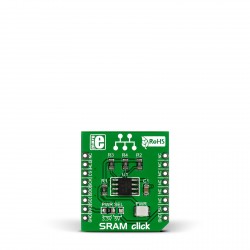Why Choose SRAM Click – A Reliable High-Speed SRAM Chip?
SRAM click carries Microchip’s 23LC1024 IC with 1 Mbit of capacity, that's 1024 kilobits. Some would say those are mebibits and kibibits and that a Megabit is 1000 kilobits. Are they right? Read on to see.
Even though the majority of us were taught in school or elsewhere that bits and bytes grow to kilos, megas and gigas by powers of 2, the not so well known fact is that in the late nineties we were supposed to settle on base-10 definitions for digital memory. So a megabit is officially 1000 kilobits.
Important trade organizations with names in acronyms agree on this: IEEE (Institute of Electrical and Electronics Engineers), IEC (International Electrotechnical Commission), NIST (National Institute of Standards and Technology).
It was a utilitarian compromise. Base-10 definitions of kilo (mega, giga…) bits/bytes complicate matters for people who work with ones and zeros. But for people who are not so digitally enlightened the base-10 system is much more sensible. And they vastly outnumber the first group.
IEC introduced alternative measurements for those who didn't want to live in a world were a kilobyte is 1000 bytes. Namely, a set of prefixes that sound like names for kittens: kibi, mebi and gibi. So a kibibit would be 1024 bits and so on.
So how come most of the data sheets you look at, including the one for the chip on SRAM click, still define megabits as 1024 kilobits? Haven't Chip Makers received the memo from IEEE, IEC or NIST?
Turns out there's fourth trade organization which defies the three above: JEDEC (Joint Electron Device Engineering Council). JEDEC has its own memory standards for semiconductor memory circuits and storage devices. Things get fuzzy here because JEDEC doesn't say which convention should be followed, but rather, they don't explicitly discard the common kilobit = 1024 bits usage. Apparently, that was enough of a straw for the semiconductor industry to hang onto, so, you can safely continue to use whichever convention suits you.
As the saying goes: "the nice thing about standards is that you have so many to choose from."
SRAM Click for Embedded Systems – Efficient Memory Storage
SRAM Click integrates a high-speed SRAM chip, providing fast and efficient data storage for microcontroller applications. Unlike traditional memory solutions, this SRAM chip-based module ensures low power consumption and optimal performance.
But for add-on boards, the choice is clear. Go with click boards and the mikroBUS™ standard. To explore the full capabilities of the SRAM Click SRAM chip module, visit the SRAM Click product page. The Libstock example is also ready.
Yours sincerely,
MikroElektronika













